I wish I could remember how many times I’ve heard, “Hey, when you go to the track, please take me with you. Maybe I could carry your camera bag, your c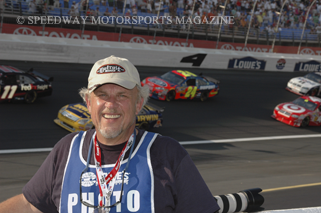 amera or even you. It must be really cool to be out there so close to the cars, not to mention the drivers, the excitement and the exclusivity of it all”. I always try to explain the best way I can that credentials are not easy to come by and that although I’d love to have a pack animal tote around my camera gear, it just isn’t possible, although sometimes secretly I wish it was. amera or even you. It must be really cool to be out there so close to the cars, not to mention the drivers, the excitement and the exclusivity of it all”. I always try to explain the best way I can that credentials are not easy to come by and that although I’d love to have a pack animal tote around my camera gear, it just isn’t possible, although sometimes secretly I wish it was.
I suppose from their standpoint, track access and the ability to mingle with the likes of Jeff Gordon, Tony Schumacher, Danica Patrick, John Force, Carroll Shelby and Tony Stewart sounds pretty good but there’s more to the picture and that’s the subject of this article.
The articles and the images that appear on Speedway Motorsports Magazine don’t happen by chance. It’s the culmination of a lot of hard work and preparation that takes place even before the race begins. Take for example, a typical NASCAR weekend. If you’re lucky enough to live close to a major racing facility like Infineon Raceway, you show up on Thursday to pick up your credentials, and make sure you have a loc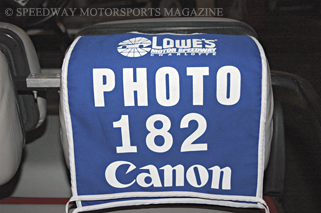 ker to store your gear along with a reserved spot in the media center to set up your laptop. Failure to do so will result in great disappointment because by Friday you’re S.O.L. if you haven’t already staked a claim. Ditto for tracks like Atlanta, Charlotte, Bristol, Las Vegas, Fontana and Michigan. The drill is the same at these facilities and you can’t afford to be caught napping, never ever. I forgot to mention about factoring in the costs of traveling, lodging, car rental and meals when the track isn’t in your own backyard. ker to store your gear along with a reserved spot in the media center to set up your laptop. Failure to do so will result in great disappointment because by Friday you’re S.O.L. if you haven’t already staked a claim. Ditto for tracks like Atlanta, Charlotte, Bristol, Las Vegas, Fontana and Michigan. The drill is the same at these facilities and you can’t afford to be caught napping, never ever. I forgot to mention about factoring in the costs of traveling, lodging, car rental and meals when the track isn’t in your own backyard.
Next comes the photo gear. I use something like a pre-flight checklist and it goes like this: two Nikon DSLR cameras (check), two Quantum Turbo Compact battery packs (check), one Manfroto monopod (check), camera cleaning equipment (check), one Dell laptop w/mouse (check), one Sigma 50-500mm lens (check), one Nikon 28-105 mm lens (check), one Nikon 12-24mm lens (check), one Nikon 80-200mm VR lens (check), two bungee cords (check), hearing protection (check), two shock proof plastic camera cases w/wheels, of course (check), business cards and pens (check), two Nikon SB-800 speedlights and AA batteries (check), one Epson digital storage device (check), eight 1GB Lexar compact flash cards (check), one CF card reader (check), one photo vest (check), sunsc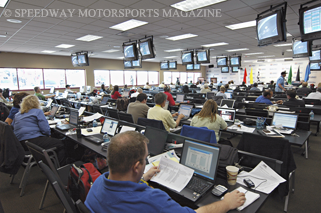 reen and Ibuprofen (check), one hand held cooling fan (check) and most importantly, the willingness and strength to cart this load whether it be to a destination 35 miles or 2000 miles away for the privilege of taking pictures and writing articles (check). reen and Ibuprofen (check), one hand held cooling fan (check) and most importantly, the willingness and strength to cart this load whether it be to a destination 35 miles or 2000 miles away for the privilege of taking pictures and writing articles (check).
This brings us up to Friday. There’s a big day ahead but you better be at the track by 7:00AM so you’ll be able to slide into an unreserved parking space in the media lot. Sure you have a media parking pass but it's first come, first served. Dawdle a little bit at breakfast savoring that delicious cinnamon roll that you’ve been fantasizing about all week and you’re summarily demoted to the B-List lot somewhere over the rainbow.
Your next task is to unload your equipment and flag down the media shuttle, load your grips (again) in the van and enjoy the journey crammed with twelve or thirteen other photographers to the media center. Once you arrive at your final destination, unload your baggage (again) and hope that you arrive in time to attend the safety meeting which is mandatory if you entertain any idea of going out on the tra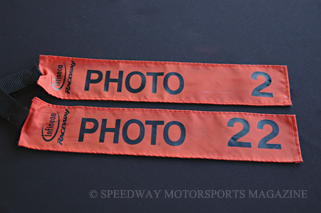 ck. The rest of the time is spent setting up your computer, getting your camera gear in order and asking that all important question, “What’s the weather going to be like?” ck. The rest of the time is spent setting up your computer, getting your camera gear in order and asking that all important question, “What’s the weather going to be like?”
Weather, in many ways, sets the mood for the weekend, especially when you know it’s going to be hot. Take Fontana, for example. During the NASCAR Labor Day weekend of 2007, the temperature never dipped below 102 degrees. On race day, legend has it that it was 113 degrees with a track temperature approaching 130 degrees. If there’s any luxury in all of this, it can be found in the willingness of the tracks to provide transportation in luxurious open air golf carts to those areas that offer the best photo ops. If you’re at an oval track, your designated media chauffeur will take you to the turn of your choice and drop you off. Just be sure to make arrangements with him to pick you up, too, or you’ll wish you had. It's a long walk back to the media center. If you’re at a road course, be prepared to chart a course over uneven, dusty and slippery terrain, and expect to either walk on or over snakes, dead rats, deer scat and hos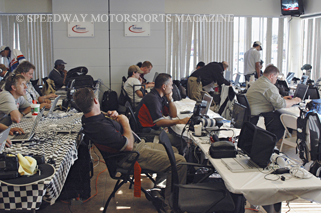 tile insects. Shade? Forget it, along with the porta-potties and the concession stands; they’re out of reach and in some cases out of sight. tile insects. Shade? Forget it, along with the porta-potties and the concession stands; they’re out of reach and in some cases out of sight.
After all of this you’re finally ready to take some pictures and your success is determined upon how well you did in your assertiveness class and how willing you are to put into practice what you learned in order to establish your place in the photographer food chain. Some spots at each track are coveted by certain individuals who guard them as a mother bear does her cubs. If you don’t get there before they do, it’s to the back of the bus with you.
Repeat all this for three days and you get the picture of what it’s like to bask in the glow of automotive racing photography. Until you do it, it sounds like a pain but once you’re there you’ll never want to leave … ever.
|





